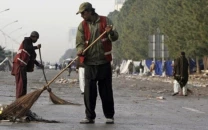Panicked residents flee Jhang city
Next 20 hours ‘extremely crucial’ for deluged city.

The swollen Chenab River is rampaging through central Punjab, leaving a trail of destruction in its wake. Authorities said on Tuesday that the next “20 hours are extremely crucial” for the inhabitants of Jhang city which has been threatened by floods after a long time.
The local population panicked as announcements were made from loudspeakers of mosques calling for residents to evacuate the city following reports that the Jhang protective dyke would give in to the floodwaters. More than 200 villages of Jhang and Chiniot districts have been deluged and Athara Hazari tehsil of Jhang has been completely evacuated.
Hundreds fled to dry land, taking their valuables along and roads leading out of the city were choked with tractor-trolleys, donkey carts, trucks, loaders, and bull carts. The highest flood levels in the city’s history have been recorded at the Chenab and Jhelum rivers, which emerged at Trimmu headworks.
The Chenab River forms a semi-circle on three sides of Jhang city. The city is protected by two protective dykes – one of them covers the city on two sides. The most vulnerable dyke is the Thatta Mala Bund, located at a distance of 10 kilometers from Jhang city close to Thatta Mala Railway Station. The station is four kilometres from River Chenab, near the Riwaz bridge. The water from upstream is obstructed by the bridge and the railway line, diverted towards the Thatta Mala Bund.
The floodwater has swept through Chiniot and has badly hit Jhang district, where two walls were built to protect the district. One wall, the Jhang Shehar Hifazti Bund runs from Jhang up to Jhang-Chiniot Road via the Thatta Mala railway station. The second wall, Jhang Hifazti Bund, protects Jhang city.
Presently, the government is trying to protect two sugar mills owned by ruling party leaders in Jhang. Engineers of Trimmu headworks believe the flood pressure can be decreased by breaking these protective walls from Ali Pur Bund near Chund Barwana bridge. However, the floodwater would then hit the Haq Baho Sugar Mill and Hunza Sugar Mill.
The engineers have warned that if the protective walls are not broken within the next five to six hours, the floods will devastate Jhang city and surrounding areas, claiming lives, livestock and properties.
Irrigation experts say the right marginal dyke at Trimmu headworks near Athara-Hazari must be breached in order to save the city. The headworks is discharging 3,49,399 cusecs of water currently and a breach will be made when the water level exceeds 6,50,000.
The roads between Jhang and Chiniot, including Bhowana Road, are inundated, cutting off links between the two districts. More than 100 villages of 18 Hazari Jhang were vacated.
The flooding has devastated the entire central Punjab, especially the districts of Sialkot, Gujrat, Gujranwala and Sargodha. According to official figures, the deluge has swamped hundreds of villages, felling and damaging over 1,450 houses and destroying crops on 200,000 acres of farmlands. Chief Minister Shahbaz Sharif’s aide Col (retd) Shuja Khanzada told the media that subcommittees have been constituted to assess losses in the flood-hit areas.
After passing Jhang, the deluge will head South Punjab where it is likely to spell more destruction.
South Punjab
The administration has been alerted that a surge from the Indus River will reach Head Punjnad by Thursday. By midnight tonight (Wednesday), 800,000 cusecs of water is expected to pass through Rahim Yar Khan and district administration, police and army officials have begun evacuating the area. A red alert has been given for all areas on the banks of the Ravi and Chenab rivers. Villages in district Sahiwal have been submerged and 10 more villages were inundated here on Tuesday.
More rains
The Met Department has predicted scattered thundershowers with isolated heavy falls over southeast Sindh and isolated thundershowers are expected over Rawalpindi, Gujranwala, Malakand, Hazara, Peshawar, Bannu and Kohat Divisions, Mehmand, Bajaur and Waziristan Agencies, Gilgit Baltistan and Kashmir.
As per the flood warning, the Flood Forecasting Division (FFD) Lahore said the Chenab River at Punjnad is likely to attain 600,000 cusecs to 700,000 cusecs, exceptionally high flood level during the period from 1200 PST on September 12 to 1200 PST on September 15. Under this condition, the districts of Toba Tek Singh, Khanewal, Layyah, Muzaffargarh and Multan are likely to be inundated.
The National Disaster Management Authority (NDMA) further stated that high levels of flood have reached Trimmu Headworks, where the discharge of floodwater is continuously being monitored. The NDMA chairman is in the field and has met with authorities to take immediate steps to cope with the situation.
The NDMA has already dispatched 10,000 tents, 31 boats, and 100 life jackets to the government of Punjab and 200 tents, 1,000 blankets and three rubber boats to Islamabad Capital Territory. In addition, 3,000 tents, 3,000 blankets and 1,500 plastic mats have been dispatched to State Disaster Management Authority and 275 tents have been provided to Gilgit Baltistan Disaster Management Authority. As many as 2,300 Army troops, 12 helicopters and 574 boats are taking part in the rescue operations.
Alert in Balochistan
On Tuesday, Balochistan Home Minister Mir Sarfaraz Bugti said the provincial government has imposed a flood emergency in the province, in view of possible flash floods in the districts of eastern Balochistan bordering Sindh. Possible floods are expected on September 16 and 17, the home minister said. Red alerts have been issued in in Jaffarabad, Naseerabad, Sohbatpur and Dera Bugti districts.
Published in The Express Tribune, September 10th, 2014.



















COMMENTS
Comments are moderated and generally will be posted if they are on-topic and not abusive.
For more information, please see our Comments FAQ